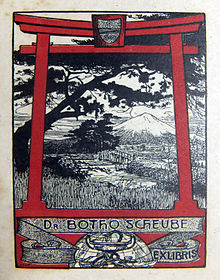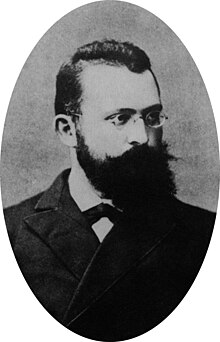Heinrich Botho Scheube

Heinrich Botho Scheube (born August 18, 1853 in Zeitz ; † March 4, 1923 in Greiz ) was a German physician and university professor who taught at the Kyoto Medical School from 1877 to 1881 and was one of the pioneers of Ainu research.
Life
Scheube was born as the first child of the factory owner Hugo Heinrich Scheube in Zeitz, a town in the south of Saxony-Anhalt . After attending the Domgymnasium in Naumburg, he first studied natural sciences from 1871, then medicine in Leipzig, where he received his doctorate on January 12, 1876. During these years he learned a. a. Erwin Bälz , who had worked as an assistant to the internist Carl Reinhold August Wunderlich since 1872 and was appointed to the Tokyo Medical School in 1877 through contacts with a Japanese patient. Wunderlich was one of Scheube's examiners for his doctorate. After only a few months of study in Vienna, Scheube also became his clinical assistant.
In October 1877 Scheube accepted an invitation from the Japanese government and went as the successor to the Dutchman GG van Mansvelt and the Kyōto Medical School founded in 1872 (today Kyōto Prefectural Medical University). Here he gave lectures on internal medicine, physiology, histology and diagnostics. At the same time he was head of the government hospital there. In 1880, while on vacation, he went on a research trip to Hokkaidō , where he examined the customs and traditions of the Ainu . This activity ended in December 1881.
In 1882 he made extensive journeys through China, Siam, Java and Ceylon and returned to Leipzig in October 1882. In December of that year, he submitted an application to the university's medical faculty for a habilitation in internal medicine with a text on "Japanese Kak-ke". The trial lecture took place on January 27, 1883. From 1883 he held lectures on clinical propaedeutics and urinalysis as a private lecturer. At the same time he worked as a general practitioner in Leipzig. In 1885 the "Princely Reuss-Plauische Landesregierung offered him the position of a city and country physician" in Greiz. Here, as the “Princely Reussian Sanitary Council”, he was also a doctor for the Princely Reuss family. In 1903 he also took over the management of the local state hospital. Scheube died in Greiz after a short illness.
Scheube's influence on Japanese medicine remained limited. He is known today for his contributions to the study of beriberi and tropical diseases. He also wrote a series of articles for Albert Eulenburg's Real Encyclopedia of All Medicine and translated scientific works into English and German. With regard to Japan, he is one of the pioneers in Ainu research. Its extensive ethnological collection was bought in 1909 by the Museum für Völkerkunde in Leipzig .
Works
- Jōyōhōkan (translated by Esaka Hidesaburō), Kyōtō, 1879 ( 慕 都 胥 乙 辺 原著 著 、 江 阪 秀 秀 三郎 訳 『常用 方 鑑』 京都 療 病院 . 73pp.)
- Kakke byōron (translated by Esaka Hidesaburō et al.), Kyōtō, 1884 ( 慕 都 胥 乙 辺 原著 、 江 坂 秀 三郎 [ほ か] 訳 『脚 気 病 論』 京都 府 立 療 病院 、 若 林茂 助 . 381pp.)
- The Baerencultus and the Ainos Bear Festival . In: Mittheilungen der Deutsche Gesellschaft für Natur- und Völkerkunde Ostasiens, Volume III (1880–1884), Issue 22, pp. 44–54
- Scheube, B. / Doederlein, Dr. L. / Naumann, Dr. Edmund: Smaller messages (Yezo, Jungfernkranich, adder). In: Mittheilungen der Deutsche Gesellschaft für Natur- und Völkerkunde Ostasiens, Volume III (1880–1884), Issue 22, pp. 88–89
- Contributions to the history of the Kak-ke . In: Mittheilungen der Deutsche Gesellschaft für Natur- und Völkerkunde Ostasiens, Volume III (1880–1884), Issue 24, pp. 170–174
- The Ainos . In: Mittheilungen der Deutsche Gesellschaft für Natur- und Völkerkunde Ostasiens, Volume III (1880–1884), Issue 26, pp. 220–250 ( digitized from Google Books )
- Notes on the diet of the Japanese. A contribution to the comparative physiology of food . In: Mittheilungen der Deutsche Gesellschaft für Natur- und Völkerkunde Ostasiens, Volume III (1880–1884), Issue 27, pp. 282–294
- The Japanese Kak-ke ( Beri-beri ) , Leipzig: JB Hirschfeld, 1882
- The Filaria disease , Leipzig: Breitkopf u. Härtel, 1883
- Clinical propaedeutics: a textbook of clinical examination methods , Leipzig: FCW Vogel, 1884
- Further contributions to the pathological anatomy and histology of the Beri-beri (Kak-ke) . 1884
- Clinical Observations on the Diseases of Japan , Virchow's Archives 1885
- Considerations on Voit's theory of human protein requirements . Leipzig: Hirschfeld, 1889
- Beriberi disease: a geographical and medical study , Jena: Fischer, 1894
- The diseases of the warm countries , Jena: Gustav Fischer 1896
- The Beriberi Epidemics at Richmond Asylum in Dublin . Archives for Ship and Tropical Hygiene, 1898
- About climatic bubones . German Archive for Clinical Medicine, 1899
- The diseases of the warm countries. A handbook for doctors . Jena: G. Fischer, 1910
- History of medicine among the East Asian peoples . In: Neuburger, Max / Pagel, Julius: Handbook of the history of medicine. Jena, 1902, Vol. 1, pp. 20-51
literature
- Pagel, Leopold Pagel: Biographical Lexicon of Outstanding Doctors of the Nineteenth Century , Berlin, Vienna 1901, Sp. 149 ( digitized version )
- Schnee, Heinrich: German Colonial Lexicon . Leipzig: Quelle & Meyer 1920, vol. 3, p. 268 ( digitized version )
- Fischer, Isidor: Biographical Lexicon of the Outstanding Doctors of the Last Fifty Years , Volume 2, Munich-Berlin: Urban & Schwarzenberg, 1962.
- Hermann Heinrich Vianden: The introduction of German medicine in Japan during the Meiji period . Düsseldorf: Triltsch, 1985, pp. 180-185
Web links
- Overview of Heinrich Botho Scheube's courses at the University of Leipzig (summer semester 1883 to summer semester 1885)
- Deutsches Kolonial-Lexikon (1920), Volume III, p. 268
Remarks
- ↑ Short biographies can be found in Pagel and Fischer. The best biography so far comes from Vianden (1985).
- ↑ According to Vianden, the topic of his dissertation is no longer verifiable
- ↑ Kakke ( 脚 気 ) is the traditional Sino-Japanese name for beriberi
- ↑ Reference works give various dates. The death certificate of the registry office in Greiz (year 1923, no. 62) determined by Vianden (1985, p. 223) mentions March 4, 1923.
| personal data | |
|---|---|
| SURNAME | Scheube, Heinrich Botho |
| BRIEF DESCRIPTION | German physician, university professor, Ainu researcher |
| DATE OF BIRTH | August 18, 1853 |
| PLACE OF BIRTH | Time |
| DATE OF DEATH | March 4, 1923 |
| Place of death | Greiz |
